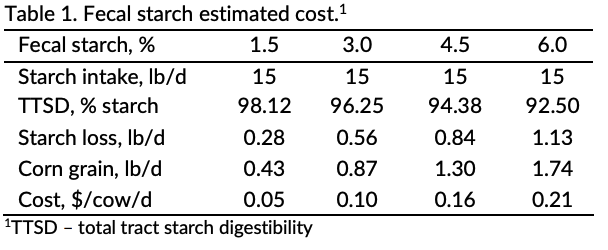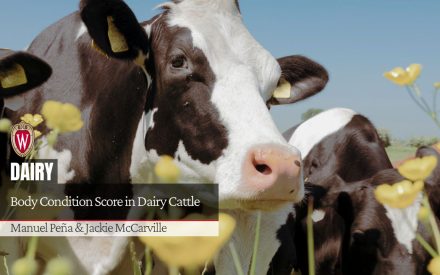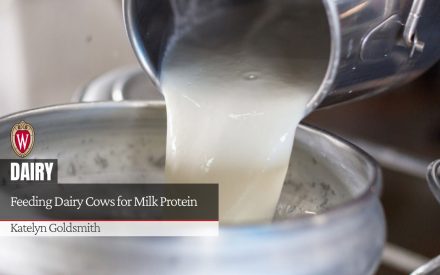Starch digestibility varies greatly within and among feedstuffs and thus, evaluating starch digestibility is essential for satisfactory diet formulation, nutritional management, and income over feed costs. Commercial laboratories that offer feed analysis have multiple options to measure starch digestibility of feeds and forages, and fecal starch is one of these options. Research developed at UW-Madison (Fredin et al., 2014) revealed fecal starch is an accurate predictor of total tract starch digestibility and could be used as an on-farm tool for evaluation of starch digestibility in lactating dairy cow diets. Each 1%-unit of fecal starch is equivalent to a reduction of 1.25%-units in total tract starch digestibility. Measuring fecal starch allows for the detection of diets with less-than-optimal starch digestibility, along with subsequent tweaks and reassessment of the diet. Optimal digestion of starch may improve lactation performance or feed efficiency.
Jump to the fecal starch calculator
Fecal starch facts
- Fecal starch is a metric for starch digestibility of TMRs and does not provide any information about specific
feeds or forages. If fecal starch levels are suboptimal, a thorough evaluation of individual starchy feedstuffs as well as nutritional management is needed. The most common causes of high fecal starch are poorly processed corn silage, coarsely-ground dry and high-moisture corn, or the transition from year-long fermented silage to new silage fermented for a short period. - Fecal starch does not indicate the site of starch digestion. Even though ruminal and total tract starch digestibilities are highly related (Ferraretto et al., 2013), fecal starch only reflects total tract digestibility.
- Fecal starch evaluation requires pen-based sampling. Briefly, collect fecal grab samples from at least 10 cows or undisturbed, fresh fecal piles in a pen. If collecting from piles, preference should be given to piles you observed cows defecating. Homogenize samples in a container (i.e., bucket). Subsample material into a shipment container. Do not fill more than 2/3 of the container to allow for expansion during shipment. Cool or freeze samples immediately to stop fermentation and submit to the laboratory of your choice with their required forms.
- If fecal starch is less than 3%, total tract starch digestibility is greater than 96%. Continue to keep track of starch sources and nutritional management to maintain high levels of starch digestion.
- If fecal starch is greater than 3%, opportunities for improvements exist. Evaluate individual starch sources and nutritional management to identify the source of the problem. If any changes are made, wait at least 2 to 3 weeks prior to reevaluating as cows need some time to adapt. Make sure samples from the same pen(s) are collected when reevaluating fecal starch.
Fecal starch calculator
The fecal starch calculator spreadsheet aims to calculate the value of starch lost in manure. This value is based on the equivalent amount of digestible starch in dry ground corn. In other words, we calculate the amount of dry ground corn that would be needed to replace the starch lost in the manure.
Inputs
Fecal starch concentration (% DM) is the only information truly required for these calculations. However, inputting the other information based on the specifics for the dairy is suggested. These are the other inputs utilized to calculate the cost ($/cow/d) of fecal starch:
- Dry matter intake (lb/cow/d) of the pen being evaluated for fecal starch. The default value is 60 lb/cow/d.
- Starch concentration (% DM) of the diet fed to the pen being evaluated for fecal starch. The default value is 25%.
- Starch concentration (% DM) of dry ground corn. The default value is 70%.
- In vitro or in situ ruminal starch digestibility (% of starch) of dry ground corn. The default value is 60%.
- Corn grain price ($/bushel). The default value is $6.73. Using up to date regional values is advised.
Outputs and calculations
The first step is predicting starch loss (lb/cow/d), which is the amount starch not digested by the cow and excreted in the manure. This value is based on starch intake (lb/cow/d) and total tract starch digestibility (% of starch intake).
Starch intake = dry matter intake * (starch % of the diet /100)
Total tract starch digestibility = 100 – (fecal starch % * 1.25). (Equation by Fredin et al., 2014)
Starch loss = starch intake * ((100 – total tract starch digestibility) / 100)
The second step is to estimate the amount of digestible starch for each unit of dry ground corn. This step requires predicting starch rate of disappearance (kd,%/h), total tract starch digestibility (% of starch) of corn grain and concentration of digestible starch (% of DM). Starch kd is predicted using the in vitro or in situ starch digestibility and a lag time of 1 h. Based on rates of disappearance and passage (kp; 12%h, Hoffman et al., 2012), ruminal starch digestibility is predicted, and total tract starch digestibility is estimated.
Total tract starch digestibility = 82.22 + (0.185 * ruminal starch digestibility). (Equation by Ferraretto et al., 2013)
Digestible starch (% DM) = starch % / (estimated total tract starch digestibility / 100)
Digestible starch (lb/lb of corn) = digestible starch / 100
Last, the model calculates the amount of extra corn grain (lb/cow/d) needed to replace the starch lost in manure using corn digestible starch (lb/lb of corn). Based on corn prices the cost/cow/d is estimated.
Extra corn grain = starch loss / digestible starch.
Example
Table 1 shows calculations for fecal starch values ranging from 1.5 to 6.0%. For this example, the default values were used:
Dry matter intake – 60 lb/cow/d
Dietary starch concentration – 25% of DM
Corn grain starch concentration – 70% DM
In vitro starch digestibility – 60% DM
Corn price – 6.73$/bushel

References
Ferraretto, L. F., P. M. Crump, and R. D. Shaver. 2013. Effect of cereal grain type and corn grain harvesting and processing methods on intake, digestion, and milk production
by dairy cows through a meta-analysis. J. Dairy Sci. 96: 533-
550.
Fredin, S. M., L. F. Ferraretto, M. S. Akins, P. C. Hoffman, and R. D. Shaver. 2014. Fecal starch as an indicator of totaltract starch digestibility by lactating dairy cows. J. Dairy Sci. 97: 1862-1871.
Hoffman, P. C., R. D. Shaver, and D. R. Mertens. 2012.
Feed GrainV2.0 background and development guide. UW Extension.


 ▶️ Watch: Hay There! Let’s Talk Feed Centers and Inventory
▶️ Watch: Hay There! Let’s Talk Feed Centers and Inventory Body Condition Score in Dairy Cattle
Body Condition Score in Dairy Cattle ▶️ Watch: Prácticas de manejo para mejorar la calidad del forraje
▶️ Watch: Prácticas de manejo para mejorar la calidad del forraje Feeding Dairy Cows for Milk Protein
Feeding Dairy Cows for Milk Protein


